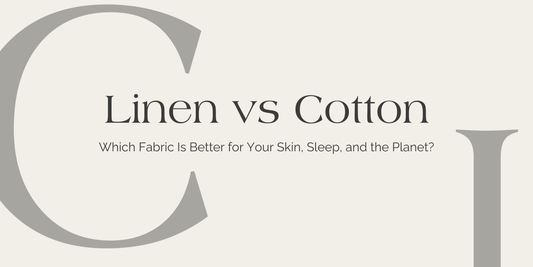Let’s get one thing straight: not all bed linen is created equal. Despite what sleek packaging or high thread counts might suggest, buying good bedding is far from straightforward. And if you’ve ever found yourself wondering why your sheets feel stiff, wear out quickly, or trap heat like a plastic tarp—you're not imagining things.
Here’s what most people get wrong about bed linen, what brands don’t always tell you, and what actually matters when you’re choosing the fabric that touches your skin for eight hours a night.

1. Thread Count Doesn’t Mean What You Think It Does
Let’s kill the myth first: thread count is not a reliable measure of quality—especially for linen.
Thread count simply measures how many threads fit into one square inch of fabric. That might be useful for cotton, but even then, manufacturers game the system by using multi-ply yarns to inflate the number. In some cases, “1000 thread count” sheets are just two layers of mediocre yarn twisted together.
And for bed linen made from flax (real linen), thread count isn’t even relevant. The yarns are too thick and irregular to be counted the same way. Instead, what actually matters is GSM—grams per square meter—which reflects fabric weight and density. A 190–210 GSM linen sheet feels substantial, breathable, and softens beautifully over time.

2. Fabric Matters More Than You Think
Walk into any home store and you’ll see rows of options labeled “cotton,” “linen,” “bamboo,” “microfiber,” or some mysterious “cooling performance blend.” Here’s what they often skip over:
- Cotton is breathable and familiar, but its softness often relies on chemical finishing. It can also wear down quickly with washing.
- Microfiber (a fancy name for polyester) is smooth but traps heat and moisture, and breaks down into microplastics.
- Linen—made from the flax plant—is naturally antimicrobial, moisture-wicking, and breathable. It may feel textured at first, but softens with every wash, aging gracefully.
If you’re serious about comfort and skin health, skip the marketing buzzwords. Focus on natural fibers. And when it comes to actual bed linen, you’ll want to know not just what it’s made from—but where and how it’s made.

3. “French Flax Linen” Might Be Made in China
Yes, really.
A product can say “French linen” on the label and still be produced entirely in an overseas factory with lower standards. That’s because French flax simply refers to the origin of the plant—not the spinning, weaving, dyeing, or finishing.
True European-made bed linen will be transparent about where it’s processed. Look for certifications like European Flax®, which verifies both origin and responsible production. If a brand doesn’t list where their linen is woven or sewn, assume it’s not in Europe.
Want to dive deeper? Read the “French Linen” myth unpacked to see why that label can be more misleading than you think.

4. Your Climate—and Skin Type—Should Influence Your Choice
This might sound obvious, but many people buy sheets based on feel-in-the-store rather than how their body reacts at 3 a.m.
- Live in a humid place? Bed linen made from flax regulates moisture better than cotton or synthetic blends.
- Run hot while sleeping? Linen’s looser weave and quick-drying fibers make it ideal for thermoregulation.
- Sensitive skin or allergies? Linen is naturally antibacterial and resistant to dust mites and mildew—no need for added chemical treatments.
Choosing the right bed linen isn’t just about feel. It’s about how it performs for your body, your sleep style, and your climate.

5. Care Is Easy—But You Need to Know This One Thing
People often assume linen is high-maintenance. Not true. You don’t need to iron it. You don’t need fancy detergents. But you do need to treat it right.
- Wash in cool to warm water with mild detergent.
- Skip fabric softeners (they coat the fibers and reduce breathability).
- Tumble dry on low or air dry—and yes, linen will wrinkle. That’s kind of the point.
In fact, the more you wash high-quality bed linen, the better it gets. Unlike cotton, which often fades or pills with repeated washing, linen fibers soften, relax, and build character over time.
Need more tips? Visit our Linen Sheets Care Guide for the full lowdown.

6. Sustainable ≠ Complicated
Let’s talk sustainability. Flax is one of the lowest-impact crops out there. It needs minimal irrigation, no synthetic fertilizers, and every part of the plant gets used. Compared to cotton, which is water-intensive and often chemically treated, bed linen made from flax is a cleaner choice—for the planet and your skin.
Bonus? Because linen is naturally durable (up to 30% stronger than cotton), it lasts longer and needs replacing less often. Less waste, better value.
Final Thoughts: What You Actually Need to Know Before Buying Bed Linen

Buying bed linen shouldn’t be guesswork. And it definitely shouldn’t depend on thread count alone. Here’s what to remember before you hit “add to cart”:
- GSM matters more than thread count (especially for linen).
- Look beyond the label—ask where it’s made, not just what it’s made from.
- Choose fabrics that work with your sleep style, not against it.
- If it says “French linen” but was processed in a mega-factory in Asia, it’s not what it sounds like.
- Real bed linen lasts, softens, and keeps your body temp happy.
Buy better. Sleep better. And ignore the fluff.





